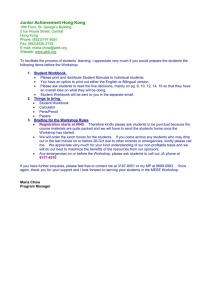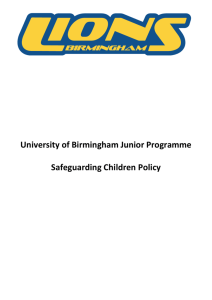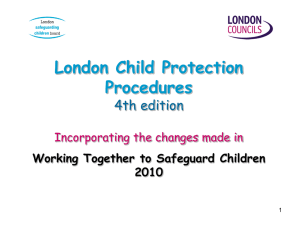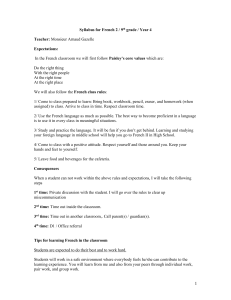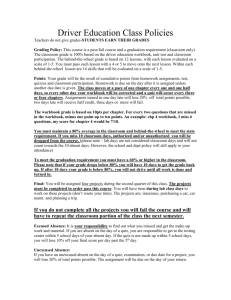Assessment criteria wording
advertisement
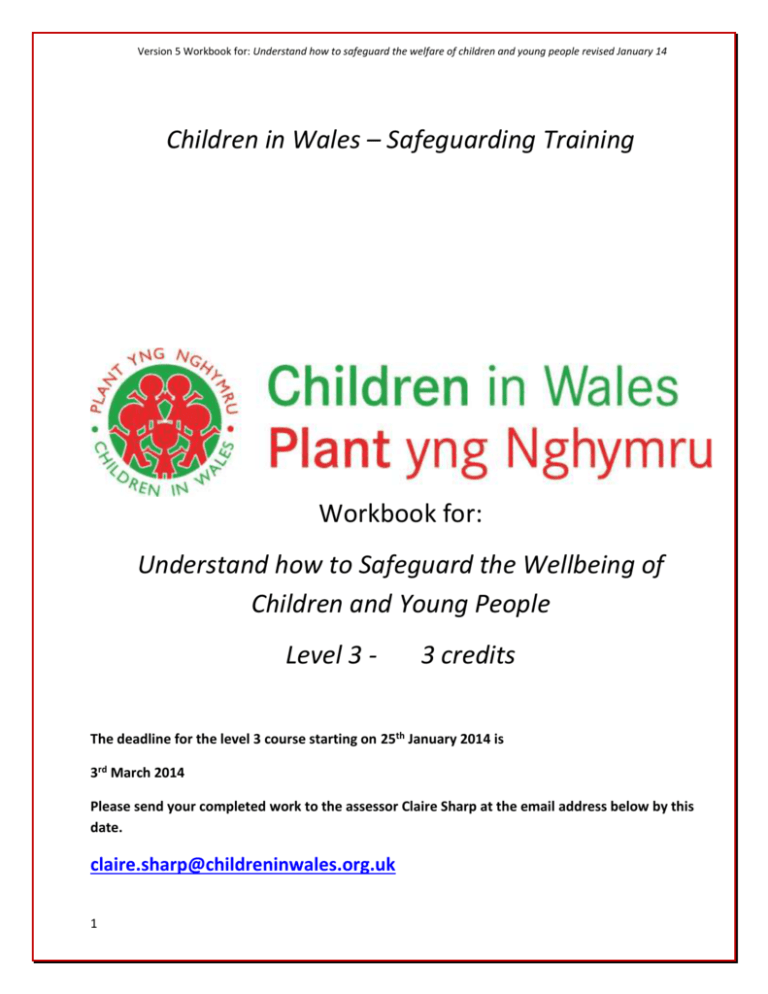
Version 5 Workbook for: Understand how to safeguard the welfare of children and young people revised January 14 Children in Wales – Safeguarding Training Workbook for: Understand how to Safeguard the Wellbeing of Children and Young People Level 3 - 3 credits The deadline for the level 3 course starting on 25th January 2014 is 3rd March 2014 Please send your completed work to the assessor Claire Sharp at the email address below by this date. claire.sharp@childreninwales.org.uk 1 Version 5 Workbook for: Understand how to safeguard the welfare of children and young people revised January 14 Welcome to the programme. This programme requires you to evidence knowledge and understanding against set learning outcomes and assessment criteria. The training will give you opportunities to develop your knowledge and understanding in the key areas in which you will be assessed. This workbook contains space for you to record entries against the specific knowledge assessment criteria put as short tasks and there is space for you to make notes during the training or in work settings afterwards. Your completed workbook should contain the evidence required for this Unit and will be used by your assessor to make an assessment judgment. You will be required to submit work within an agreed timescale which will be given to you on the course you attend. All assessed work will be graded as having met all the assessment criteria, or requiring further work in order to meet the assessment criteria. Learners will be offered an opportunity to resubmit referred work one further time and if this does not meet the assessment requirements on this occasion it will be treated as a Fail. Written feedback will be sent to you. If successful your certificate will be issued following quality assurance verification. Assessment This unit is a Knowledge unit to show achievement of understanding, with no requirement for demonstrated competence. The unit is at Level 3 and is valued at 3 credits. This unit is part of the QCF Diploma in Children’s Care Learning and Development and once achieved can be used directly as part of this Diploma (or any other QCF qualification that contains this unit). The learning and evidence of knowledge and understanding can also be mapped against other similar units to show full or partial achievement and this is known as Recognition of Prior Learning (RPL). Learning will be achieved through participation on the Children in Wales Safeguarding Training provided through Cardiff Workforce Development and additional work on the assessment tasks completed after you have undertaken the training. Some evidence can be gathered during the course while you are working and learning. The Level 3 unit Understand how to Safeguard the Wellbeing of Children and Young-people contains seven Learning Outcomes (LOs). Each Learning Outcome has several Assessment Criteria (ACs). Each AC will need to be evidenced through completion of the workbook tasks. You will need to refer back to the assessment criteria on pages 5-7 of this booklet when you complete the tasks to ensure that you are addressing these fully through your written response to the tasks. Assessment criteria wording When you are considering how to ensure you meet the assessment criteria you should have a look at the wording of the assessment criteria because the clues are in the verbs: 2 Version 5 Workbook for: Understand how to safeguard the welfare of children and young people revised January 14 Describe – provide details about a topic or item Outline – list the key information Identify – recognise and pull out the main points from a bigger piece of information Explain – provide details about a topic or item with reasons or examples, i.e how does it work in practice. Analyse – examine a topic in detail to explore the meaning, essential features and significance – this often requires providing more than one perspective on practice and/or theory Evaluate – review theory and/or practice in a way that shows clearly the points for and against, and make a reasoned judgement. What needs to be done to make something work better? Three hot tips! 1. Plan to make progress – give yourself several mini-deadlines to complete pieces of work. 2. You do not have to complete the workbook tasks in the order that they are laid out. Start with something that you feel more confident to answer and then move on to something that may be more of a challenge for you. 3. Map your work to the assessment criteria, if you think that the answer you have written for one learning outcome also provides evidence for another task then cross reference this piece of writing with the number of the assessment criteria. Plagiarism This means using another person’s work whilst presenting it as your own. This may include; using information from a formal written source and not acknowledging where a quotation or paraphrase comes from, or submitting some or all of the work of another learner in a way that suggests that it is your original work when it is not. Part of the experience of being a learner studying this unit is exchanging views and using the ideas of other people – provided that they are acknowledged in what is written. If you want to use short quotes from other sources make sure that you use quotation marks and identify where you have found this information. If you are sharing ideas for the workbook with a colleague on the course it is alright to discuss the tasks together but you need to write your tasks separately as you are required to produce an individual response to the work. If you present work that is plagiarised then it is likely that you will not pass the assessment. Access to fair assessment You have a right to be fairly assessed. If you are unhappy about the way your award is managed, taught or assessed please contact either your assessor, your training provider or your verifier of quality assurance. If you wish to take this further you will be informed of the Appeal policy. The purpose of the appeals policy is to enable learners to appeal against an assessment decision which has not been resolved by informal action. In the event of an assessment decision that a learner is not satisfied with, the policy can be accessed through Caroline Taylor at Children in Wales. caroline.taylor@childreninwales.org.uk . Deadlines Assessors will give you a deadline for submission of your work. If you cannot meet this deadline then you will be told about the arrangements for late submissions. The assessor will also inform you about the procedures for submission. 3 Version 5 Workbook for: Understand how to safeguard the welfare of children and young people revised January 14 Learner name: Learner contact details: Date of submission: Purpose and Aim of the unit: This unit provides the knowledge and understanding required to support the safeguarding of children and young people. The unit contains material on e-safety. LEARNING OUTCOMES - The learner will: ASSESSMENT CRITERIA - The learner can: 1. Understand the main legislation, guidelines, policies and procedures for safeguarding children and young people 1.1 Outline current legislation, guidelines, policies and procedures within own UK Home Nation affecting the safeguarding of children and young people 1.2 Explain child protection within the wider concept of safeguarding children and young people 1.3 Analyse how national and local guidelines, policies and procedures for safeguarding affect day-to-day work with children and young people 1.4 Explain when and why inquiries and serious case reviews are required and how the sharing of the findings informs practice. 1.5 Explain how the processes used by own work setting or service comply with legislation that covers data protection, information handling and sharing. 2. Understand the importance of working in partnership with other organisations to safeguard children and young people 2.1 Explain the importance of safeguarding children and young people 2.2 Explain the importance of a child or young person centred approach 2.3 Explain what is meant by partnership working in the context of safeguarding 2.4 Describe the roles and responsibilities of the different organisations that may be involved when a child or young person has been abused or harmed 4 Evidenced Version 5 Workbook for: Understand how to safeguard the welfare of children and young people revised January 14 3. Understand the importance of ensuring children and young people’s safety and protection in the work setting 3.1 Explain why it is important to ensure children and young people are protected from harm within the work setting. 3.2 Explain policies and procedures that are in place to protect children and young people and adults who work with them. 3.3 Evaluate ways in which concerns about poor practice can be reported whilst ensuring that whistleblowers and those whose practice or behaviour is being questioned are protected. 3.4 Explain how practitioners can take steps to protect themselves within their everyday practice in the work setting and on off site visits. 4. Understand how to respond to evidence or concerns that a child or young person has been abused or harmed 4.1 Describe the possible signs, symptoms, indicators and behaviours that may cause concern in the context of safeguarding 4.2 Describe the actions to take if a child or young person alleges harm or abuse in line with policies and procedures of own setting 4.3 Explain the rights that children, young people and their carers have in situations where harm or abuse is suspected or alleged 5. Understand how to respond to evidence or concerns that a child or young person has been bullied 5.1 Explain different types of bullying and the potential effects on children and young people. 5.2 Outline the policies and procedures that should be followed in response to concerns or evidence of bullying and explain the reasons why they are in place 5.3 Explain how to support a child or young person and/or their family when bullying is suspected or alleged 5 Version 5 Workbook for: Understand how to safeguard the welfare of children and young people revised January 14 6. Understand how to work with children and young people to support their safety and well being 6.1 Explain how to support children and young people’s self-confidence and self-esteem. 6.2 Analyse the importance of supporting resilience in children and young people 6.3 Explain why it is important to work with the child or young people to ensure they have strategies to protect themselves and make decisions about safety. 6.4 Explain ways of empowering children and young people. 7. Understand the importance of e-safety for children and young people 7.1 Explain the risks and possible consequences for children and young people of being online and of using a mobile phone 7.2 Describe ways of reducing risk to children and young people from: • social networking • internet use • buying online • using a mobile phone. 6 Version 5 Workbook for: Understand how to safeguard the welfare of children and young people revised January 14 Learning Outcome 1: Understand the main legislation, guidelines, policies and procedures for safeguarding children and young people. 1.1 Identify the key legislation, guidelines, policies and procedures in the grid sections below that are relevant to helping you safeguard the well-being of children and young people in your workplace setting including e-safety. Hint Show you have done some independent research by providing sources of information and support that you could go to if you needed additional specialist help, these could be other organisations, websites, and helplines. Make sure that the examples you provide are relevant for the Welsh context. For each piece of legislation please add a brief explanation of why it is relevant to your work Current legislation: Identify relevant current legislation that provides a framework for the practice of your setting Guidance, policies and procedures These are the documents that explain how the legislation should be applied in particular context ensure they refer to the Welsh context Where you could go to for additional information or support: Websites, helplines etc. that provide advice and support re :child protection e-safety, bullying, sexual abuse and on issues of cultural practices viewed as child abuse in the UK. Some of these could be places where children and young people could seek help directly. Give brief explanation of what helpline/ organisation can provide support with. 7 Version 5 Workbook for: Understand how to safeguard the welfare of children and young people revised January 14 1.2 Explain using full sentences what is meant by child protection within the wider concept of safeguarding the well-being of children and young people. Hint A good answer should be about 100 words 1.3 and 1.4 Analyse a Serious Case Review (SCR) that was held into child abuse; Hint 8 A good answer should contain about 500 words and focus on the learning from the case review rather than just listing the details of the case. Explain why SCR’s are needed and what they are intended to achieve. Outline the main problems that led to the abuse not being correctly identified and acted upon, including the roles of different professionals involved with this case. Identify what the main recommendations were of this SCR and how this changed working practices for people working with children and families Identify any particular implications for the policies and procedures that are used in your workplace. You can find all the Serious Case Reviews on the NSPCC web site Version 5 Workbook for: Understand how to safeguard the welfare of children and young people revised January 14 1.5 Identify two examples from your work setting that demonstrate how your working practices and record keeping comply with legislation that covers data protection, information handling and sharing of information. Hint These should be examples of how you collect and store information about the children you work with, how this is shared with their parents and other agencies appropriately and what legislation these relate to. A good answer should contain about 100 words for both examples a. b. Learning Outcome 2 Understand the importance of working in partnership with other organisations to safeguard children and young people. Read the case study below David is 3 and a half years old, he lives with his mother and his new baby sister who is 6 weeks old. David is very close to his father who has been sent to prison recently for possession of drugs. David is normally very well dressed, clean and happy when he attends your setting but you have been concerned that a few times recently he has arrived in dirty clothes and appeared to be very irritable and hungry during the session. He keeps asking when snack time is and pushing other children out of the way to get his food first. David has also become more tearful and clingy when his mother drops him off. 2.1, 2.2 2.3 & 2.4 1. Why it is important that your workplace plays a part in safeguarding the children who attend this setting. 2. How will you make sure that David remains at the centre of your approach to the situation and that his voice is heard by the adults making decisions. 9 Version 5 Workbook for: Understand how to safeguard the welfare of children and young people revised January 14 3. Explain what is meant by partnership working and what you can do to make sure that you work positively with other organisations to ensure the safety and well-being of David 4. Give details of the different roles and responsibilities of the organisations that may be working with this family and the reasons why they are involved (you should describe at least 4 organisations some of which should be those who hold statutory responsibility for addressing child protection). Hint You will need to refer to assessment criteria 2.1, 2.2, 2.3 and 2.4 from the blue chart on page 2 of this workbook. You will need to write around 500 words 10 Version 5 Workbook for: Understand how to safeguard the welfare of children and young people revised January 14 Learning Outcome 3. Understand the importance of ensuring children and young people’s safety and protection in the work setting 3.1 Explain why it is important to ensure children and young people are protected from harm within the work setting. Hint In your answer you need to refer to why particular groups of children are more vulnerable. How can childcare workers support and act as advocates for them. Why is it that some children are harmed whilst being looked after by childcare professionals? A good answer contains about 150 words 3.2 Identify three key policies and procedures in your workplace that keep children and adult safe and explain why they are effective. Hint Don’t just make a list of policies. Write in full sentences giving details why each one is necessary. 150 words 11 Version 5 Workbook for: Understand how to safeguard the welfare of children and young people revised January 14 3.3 a) Explain what is meant by the term ‘whistle blowing’. b) Identify what you would do if you were concerned about unsafe working practices in a setting or the actions of a colleague. c) What are the difficulties that might arise from challenging the working practices of others in your workplace setting? d) How would you try to ensure that whistle-blowers and other staff are treated fairly when there is an investigation into bad practice? Hint write about 30 words each for a, b, c & d 12 Version 5 Workbook for: Understand how to safeguard the welfare of children and young people revised January 14 3.4 From your work setting identify the ways you and your colleagues can take steps within your everyday practice to create a safe working environment in work and during off site visits. Hint Describe in full sentences two examples of how you can create a safe working environment. These should be practical measures that work to keep everyone safe. You should write about 50 words for each example Example 1: Example 2: Learning outcome 4. Understand how to respond to evidence or concerns that a child or young person has been abused or harmed 4.1 Using notes from the training to identify each different category of abuse, give details of the acts that fit into each category and the signs or symptoms for each of these. 13 Version 5 Workbook for: Understand how to safeguard the welfare of children and young people revised January 14 Category of Abuse Acts of abuse Signs or indicators that would raise concern of possible abuse 4.2 and 4.3 Choose one of the given safeguarding scenarios or create a relevant example for your setting and describe the key actions of how you would respond if there was evidence or concerns that there has been or is a risk of abuse or harm (including self-harm and bullying) to a child or young person. Hint Using the prompts use the space below to write your response to the scenario in full sentences, a good answer should be about 400 words and provide details of effective practice in relation to safeguarding concerns. Identify what exactly your concerns are, refer to the signs, symptoms and behaviours that are have been noticed, and the types of abuse that they relate to. What are the policies and procedures that would apply to this situation? Who would you need to speak to including where relevant the child’s family or carer and any other agencies What records would you need to keep, and how you would share information legally within the principles and boundaries of confidentiality? What rights does a child have in this situation and how would you ensure that these are upheld by the setting? What rights do parents or carers have in this situation? 14 Version 5 Workbook for: Understand how to safeguard the welfare of children and young people revised January 14 Learning outcome 5. Understand how to respond to evidence or concerns that a child or young person has been bullied Look at the case study for Lauren – Michelle works as a teaching assistant at Cwm Deri Primary School, she often supervises the children at break times. Lauren is a 7 year old girl who is tall for her age and overweight. Michelle has noticed that a small group of girls have been teasing Lauren about her size and calling her names. They have started leaving her out of their games saying she is too slow to join in, so Lauren is often left alone. Michelle finds Lauren in the toilets crying because she is so lonely and saying that she hates herself. 5.1, 5.2 and 5.3 Describe your concerns are about what is happening to Lauren and the steps that Michelle should take to support Lauren. Hint A good answer will be about 400 words in total and should cover the following points 15 The types of bullying and the consequences of these. What steps should Michelle take to support Lauren? Identify where could Michelle go to for additional support? Describe the policies that should be put in place at the school? Describe practical steps that should be taken to try and reduce the incidents of bullying at the school, and to increase empathy for victims How could the school make sure there is always support for pupils who feel that they are being bullied? You will need to refer to assessment criteria 5.1, 5.2 and 5.3 on the blue chart on page 5 of this workbook Version 5 Workbook for: Understand how to safeguard the welfare of children and young people revised January 14 Learning outcome 6. Understand how to work with children and young people to support their safety and well being 6.1 Identify the ways in which you support children to develop self-confidence and self-esteem. Hint Describe in full sentences examples of how you listen to the children you work with and help them to celebrate successes. You will need to refer to assessment criteria 6.1, 6.2, 6.3 and 6.4 on page 6 of this workbook. You should write about 100 words in total 6.2 Explain what is meant by children having resilience. Identify at least three difficulties that children might experience and explain how you can help support them in your day to day work. Hint Your answer should be about 100 words 6.3 Explain why it is important to work with children to ensure that they understand ways that they can help to keep themselves safe and can identify how to make safe decisions relevant to their situation. 16 Version 5 Workbook for: Understand how to safeguard the welfare of children and young people revised January 14 Hint write about 50 words for this and for each example in the following question 6.4 Provide at least two examples of how you can help children to keep themselves safe, and support them to have a voice in things that affect them. 1. 2. Learning outcome 7. young people Understand the importance of e-safety for children and 7.1 Explain what your main concerns are when children go online using a devise that is connected to the internet. This could include mobile phones, gaming consoles, computers and tablets. Hint What are the possible consequences for children and young people of engaging in these online activities? You should write about 200 words 17 Version 5 Workbook for: Understand how to safeguard the welfare of children and young people revised January 14 7.2 What can adults do to help reduce the risks for children and young people when they are using internet connected devises including mobile phones. Hint Please refer to how you could help protect children who are using social networking sites and when they are buying items or services online. You should write about 200 words Design a step by step guide to setting up safety/parental controls on one of the following 18 Google search Windows parental controls Smart phone Wii X box Version 5 Workbook for: Understand how to safeguard the welfare of children and young people revised January 14 I have read the induction information provided with this workbook and I confirm that the work submitted in this workbook is my own. Name of learner: Signature of learner: Date of signature: Important information Your assessor is: Claire Sharp Contact details: claire.sharp@childreninwales.org.uk Name of Assessor: Signature Date: Feedback to learner including any referral requirements: Your Internal Quality Assurance link is: Catherine Lewis Contact details: catherine.lewis@childreninwales.org.uk Sampled by IQA yes/no Name of IQA Signature Date 19

